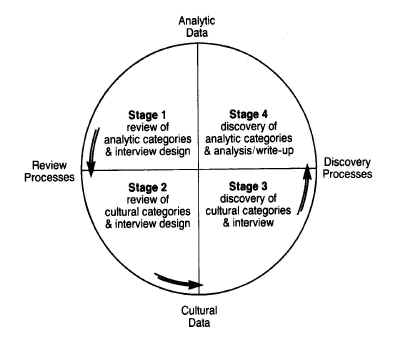The Long Interview
Instead of the three separate interviews recommended by Schuman, McCracken recommends one long interview.

The first step of the long qualitative interview begins with an exhaustive review of the literature.
Literature reviews…are not simple exercises in data collection. They are…critical undertakings in which the investigator exercises a constant skepticism. They are, in fact, a kind of qualitative analysis. They search out the conscious and unconscious assumptions of scholarly enterprises. They determine how these assumptions force the definition of problems and findings. The good literature review is a critical process that makes the investigator the master, not the captive, of previous scholarship…[It is a] review and “deconstruction” of the scholarly literature. (McCracken, 1988, p. 31)
The literature
- helps define the problems to be studied and helps assess data
- aids in the construction of interview questions.
The second step involves a self-examination.
The object of this step is to give the investigator a more detailed and systematic appreciation of his or her personal experience with the topic of interest. It calls for the minute examination of this experience. The investigator must inventory and examine the associations, incidents, and assumptions that surround the topic in his or her mind. (p. 32)
This cultural review
- helps identify cultural categories and relationships that become the basis of question formation
- prepares the investigator for the “rummaging” that will occur during data analysis
- “distances” the investigator. “Only by knowing the cultural categories and configurations that the investigator uses to understand the world is he or she in a position to root these out of the terra firma of familiar expectation. This clearer understanding of one’s vision of the world permits a critical distance from it…The investigators experiences and biases are the “very stuff of understanding and explication” (p. 32).
The third step involves developing a questionnaire.
The final questionnaire…will consist in a set of biographical questions followed by a series of question areas. Each of these will have a set of grand-tour questions with floating prompts at the ready. It will also consist in planned prompting in the form of “contrast,” “category,” “special incident,” and “auto-driving” questions. With this questionnaire in hand, the investigator has a rough travel itinerary with which to negotiate the interview. It does not specify precisely what will happen at every stage of the journey…but it does establish a clear sense of the direction of the journey and the ground it will eventually cover. (p. 37)
Begin an interview by demonstrating that the interviewer is a “benign, accepting, curious (but not inquisitive) individual who is prepared and eager to listen to virtually any testimony with interest” (p. 38). Once the preliminaries are completed, deploy grand-tour questions followed by “floating prompts.” Follow this with planned prompts:
- contrast
- category
- special incident
- auto-driving
Be alert for
- impression management
- topic avoidance
- deliberate distortion
- minor misunderstanding
- outright incomprehension
The fourth and final phase of the long interview is the most demanding. It is the analysis of the data.
The object of analysis is to determine the categories, relationships, and assumptions that informs the respondent’s view of the world in general and the topic in particular. The investigator comes to this undertaking with a sense of what the literature says ought to be there, a sense of how the topic at issue is constituted in his or her own experience, and a glancing sense of what took place in the interview itself. The investigator must be prepared to use all of this material as a guide to what exists there, but he or she must also be prepared to ignore all of this material to see what none of it anticipates. If the full powers of discovery inherent in the qualitative interview are to be fully exploited, the investigator must be prepared to glimpse and systematically reconstruct a view of the world that bears no relation to his or her own view or the one evident in the literature. (p. 42)
…..McCracken, G. (1988), The long interview. Newbury Park, CA: Sage.
Del Siegle, PhD
del.siegle@uconn.edu